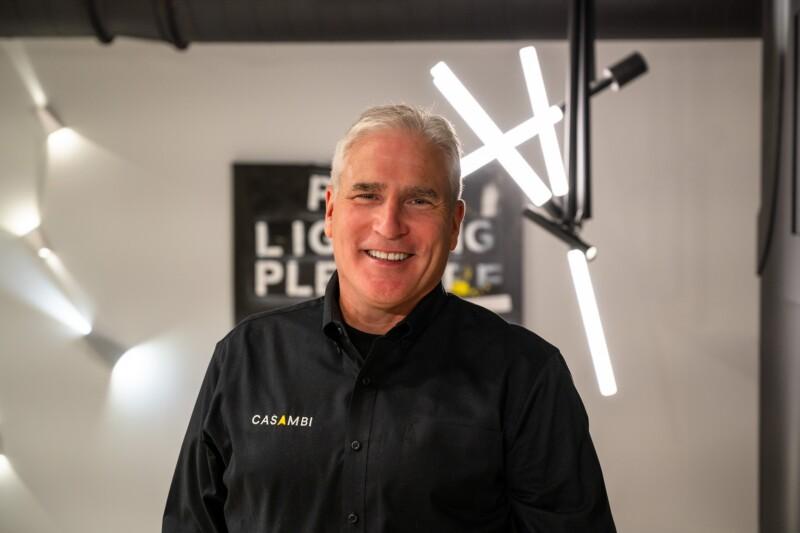Who will win the smart lighting control standards battle?

Lighting control should be simple and seamless, but it has been held back by outdated standards and inadequate technology. It’s time for a new standard, explains Timo Pakkala, founder of Casambi – the world’s leading provider of smart wireless lighting control software.
Smart lighting controls demonstrate we’re in the midst of a revolution in lighting management systems.
The rise of wireless technology and the internet of things (IoT) has brought an explosion of new suppliers and solutions, offering lighting specifiers a bewildering range of choices.
But communications technology demands standardisation, and not all these new systems can stand the test of time. Which ones will prevail in the lighting control standards battle?
One thing is for sure: at the moment it’s the customer that’s losing. The industry’s attempts to make lighting control simpler have often ended up making it more complicated than ever.
The first issue is that today’s connected light fittings usually communicate over a Wi-Fi or ZigBee network, relying on both a router and a gateway device. So your lighting control is only as reliable as your network, and the busier this gets the more likelihood there is of the signal dropping out due to interference across a constrained range of frequencies.

Flaky Wi-Fi signals are just the start of it. An even bigger issue is security. Barely a week goes by without a new IoT security scandal hitting the headlines. TVs, fridges and cameras are just some of the devices to have succumbed to hackers in recent months.
The next problem is that most lighting control systems are still based on dated standards such as DALI, DMX or 1-10V, which don’t make the most of today’s technology.
DALI has become well established since it was introduced in the 1990s, but its complex and cumbersome nature has prevented it from fully delivering on its potential. Specialists are needed to plan, install and commission DALI systems, and the cost and complication means that many clients find their DALI installations never quite work as they were intended to.
More importantly, DALI was conceived in a world very different to today’s: when computing power was limited, when the internet as we know it had hardly been born, when data only travelled over wires, and when smartphones were still nearly a decade away. Today’s world of high-speed wireless data links and handheld smart devices was impossible to imagine at the time DALI was invented.
So why, in 2017, are makers of wireless controls systems still going out of their way to accommodate the quirks and confines of a standard that’s getting on for 20 years old?
At Casambi, we thought there must be a better way. We asked ourselves: if you were inventing a lighting control system now, in 2017, how would it work?
The answer we came up with is to enable users to communicate directly with light fittings using Bluetooth Low Energy.

For our money, Bluetooth Low Energy is the communication technology for lighting control. It is already widely used to make everyday products ‘smart’, and it offers a long list of benefits for controlling lights. Not least of these is the fact that it is already built into pretty much every smartphone, tablet and laptop manufactured in the past five years.
The user simply needs to specify a Casambi-ready system, download the Casambi app to their device, and they can directly control all their fittings.

Forget about new wiring – none is required because the fittings communicate directly with the user’s device. This makes Casambi ideal for retrofit applications and sensitive buildings.
Forget about routers, gateways and hubs – Casambi’s approach takes them out of the equation too.
Forget about specially trained installers and commissioning engineers – installation is no different from any other fitting, and the commissioning process is designed so anyone can do it.
Forget about maintaining hardware and software – all the hardware required is on tiny chips built into luminaires, drivers and switches; and all the software is in our app or in the cloud.
As for security, the hacking risks that threaten Wi-Fi-based systems don’t affect Bluetooth-based systems like Casambi, which are not connected to the internet, and are only switched on when they are needed. The only time you’ll need to go online is to apply a firmware update.
The future is taken care of too, because the Casambi app updates itself automatically, and – unlike many so-called smart devices – delivers over-the-air firmware updates to your fittings. Casambi’s technology is also ideal for supporting devices that incorporate sensors and location beacons for enhanced functionality.
Our vision is for Casambi’s unique solution to be built into every luminaire, making it a new standard for lighting control – one that uses the best of today’s technology to deliver on the promise of the IoT.
We’ve already got a big stamp of approval from top lighting specifiers: in November Casambi won the prestigious Lux Award for Controls Product of the Year – an award judged by a panel of specifiers and end users of lighting.
Who wins the lighting control standards battle will ultimately be decided by customers. At Casambi, we believe that users will only get the simple, seamless control they deserve by making a break with the past and supporting a new standard that’s fit for 2017 and beyond.


